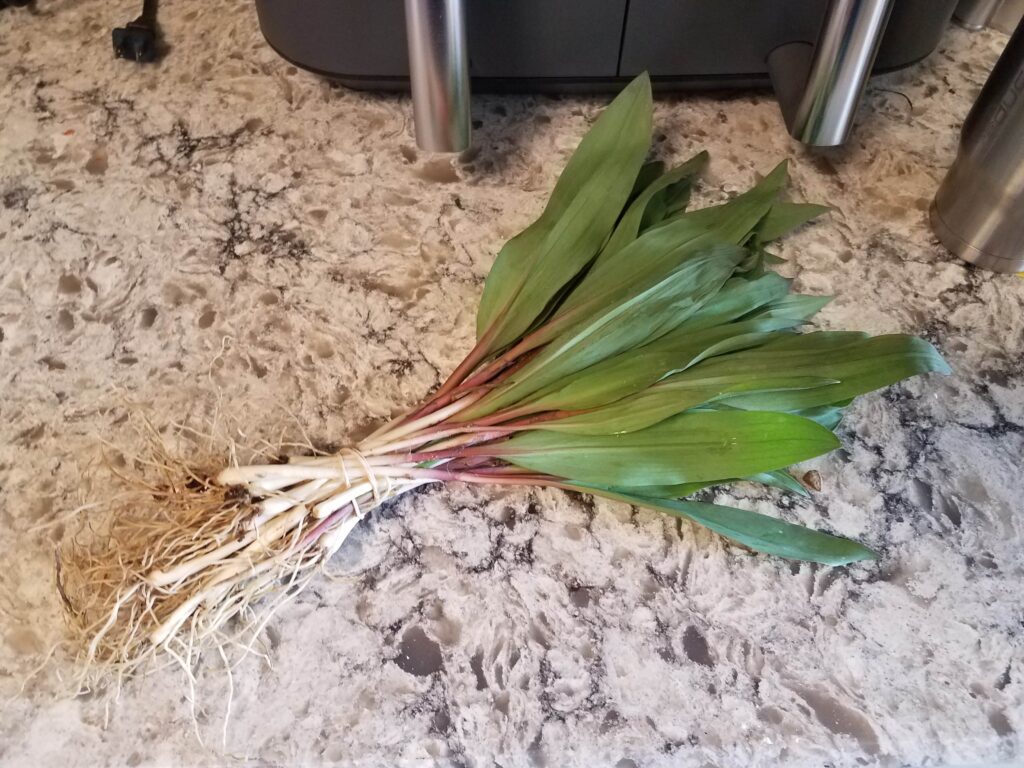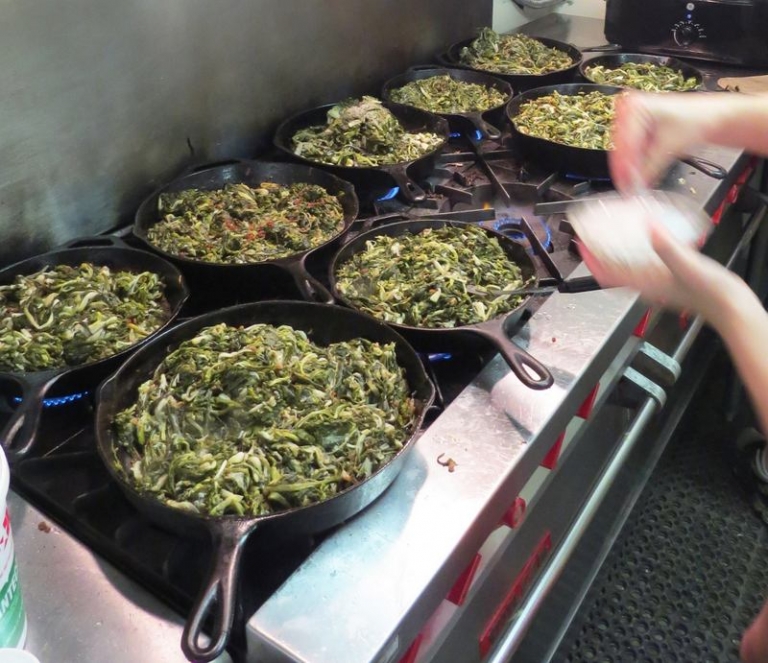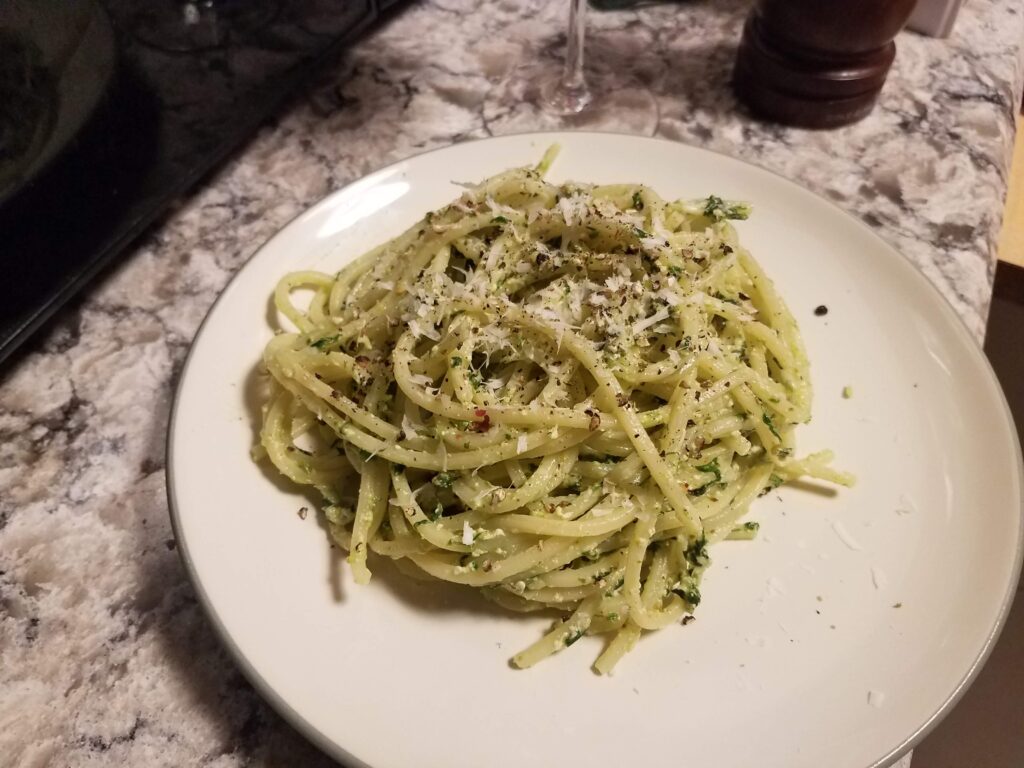Springtime is here, at least in fits and starts, and with it has come a fresh source of excitement for me almost every week as I encounter new seasonal produce in my community-supported agriculture (CSA) box. I’ve been trying to eat more intentionally this year, which includes a focus on cooking by the seasons, and I’ve enjoyed both the novelty of new ingredients as they arrive and the heightened appreciation of them as their availability is time-bound. And if we’re talking about the celebrated but brief appearance of ingredients in the spring, we need look no further than ramps…
If you haven’t heard of them, ramps are a plant in the genus Allium (home to onions, garlic, leeks, and scallions), and they can be found throughout the Appalachian region in late April and May.[1] If you have heard of them, you will know how exciting ramp season is for foodies because of their distinct flavor, the short season in which they are available, and also their limited supply during the season, as they are largely foraged, not farmed.

It is important to point out that with their constantly increasing notoriety comes constantly increasing demand, and over-foraging presents a risk to the long-term availability of this much-beloved plant. If you take nothing else away from this post, please remember that proper appreciation of ramps also means enjoying them responsibly. And as we approach the end of ramp season (already), it is important to know what to look for when you shop and when to say when.
Allium tricoccum
I had never heard of ramps (a.k.a. ramson, wild leek, wood leek, or wild garlic) until a year or so ago when Christian and I stopped at a much-loved burrito restaurant on our way through Morgantown, likely on our way to a camping trip in West Virginia. Their special of the week included ramps, and upon ordering the dish, we were initially curious and subsequently thoroughly satisfied. As it happens, West Virginia is a great place to experience ramps, as there are ramp festivals throughout the state for a brief few weeks, many of which benefit local municipalities, schools, and churches. We plan to hit one next weekend.[2]
One big factor contributing to these annual, community-based celebrations of ramps comes from their own pickiness about where they grow. They like cool, shady, wooded settings, which are plentiful throughout West Virginia, but they don’t lend themselves well to formal cultivation, making their arrival more special. Although more ramp enthusiasts are trying to grow them at home,[3] it’s often not worth it to attempt farming such a slow-growing crop for a short, if frenzied, season. And it is also the slow-growing component of these plants that contributes to the risk of over-harvesting.
The reproductive cycle of ramps takes a long time, which is why sustainable foraging is so important. They can reproduce asexually by dividing their bulbs (which is slow) or sexually through the production of seeds (which is slower). Seeds can take up to 18 months to germinate, and new plants can take up to seven years to produce seeds of their own, so you’re looking at the better part of a decade for a full reproductive cycle. Given that exceedingly long timeline, several sources say that only 10 percent of a given patch should be harvested every 10 years.[4]

Image credit: [5]
Poached Ramps
Historically a farmers’ market treat (at around $20 per pound), we’re seeing ramps creep into high-end restaurants and grocery store chains, which encourages over-harvesting and even black market trade. There are accounts of ramp poaching (not the cooking technique) in Ontario, where ramps are protected in certain forests, and transportation into Quebec, where it is illegal to harvest or sell them at all.[6] In the US, Cook County’s forest preserve police issue about 25-50 citations every year for ramp poaching, with penalties reaching $500 fines and misdemeanor charges if the ramps were taken from state land.[7]
In order to promote more sustainable and ethical practices, there are a couple things that we as consumers can do. First, treat them as a special event and don’t get greedy – that means limiting how much you get per trip and for how long. For example, buying one bunch for yourself instead of the whole stock will help to combat a “bank run” mentality. When examining produce, look for thinner, younger, more tender stalks – larger, thicker stalks get woody and are less desirable from a culinary perspective. Even so, by the end of the season, prices are rising and ethical foraging practices are dropping, in an effort to extend sales.[8] Respecting the end of the season in that way will allow more ramps to stay in the ground for next year.
To the best of your ability, find out what you can about where the ramps came from. My CSA notes them as being “sustainably wild-foraged,” which is great, but there is also no real oversight of those terms, so the more you know about your suppliers, the better. And since you can use the entire plant – leaves and all – look for bunches of leaves if you can get them. Whether you’re foraging for yourself or buying from a farmers market, a great way of ensuring sustainable harvesting is simply by cutting off just one of the leaves and leaving the rest of the plant in the ground to continue growing. Even the ramp recipe I tried this week was heavy on the leaves and light on the stems.
Recipe: Creamy Ramp Pesto Pasta
I was on the waitlist for ramps in my CSA subscription this past week and lucked out when a quarter-pound bunch arrived. There are a wealth of recipes online, and the one I tried was featured on the CSA’s blog, with a nod to the original source in the New York Times.[9] Reducing the size of the recipe made things a little difficult in my food processor because there was less volume to chop and mix, but it might work better in a blender if you’re dealing with smaller, more responsible quantities.

The recipe also called for all the leaves and a quarter of the stems, but I used everything for the full effect… and could still taste them the next day. If you’re a fan of the intense raw ramp taste, you could do worse than this pesto on pasta. Though I’d suggest not pairing it with anything expensive – my delicate pinot tasted like water.
Ingredients:
- 1 bunch of ramps (about ½ lb)
- 1 lemon (zest and juice)
- ¼ c shelled pistachios, toasted
- ½ c grated parmesan
- ⅓ c extra virgin olive oil
- ¾ c ricotta
- 1 lb pasta (bucatini or spaghetti)
- Salt & pepper
Prepare a pot of boiling water and an ice bath in a medium bowl.
Clean the ramps, separating the leaves from the stems. Blanch leaves in boiling water for 15 seconds, move immediately to the ice bath, and then dry on a kitchen towel.
Pulse blanched leaves and ¼ of the bulbs and stems in a food processor with lemon zest and juice, pistachios, and parmesan. Slowly add the olive oil in a stream while processing. Taste and continue to add bulbs and stems to your liking, then add salt as needed. (If you don’t use all of the bulbs/stems, you can save them for other great ramp recipes.)[10]
Salt pasta water once it is boiling and cook pasta for one minute less than package directions. Reserve ½ c of the pasta water and add it to the ricotta in a separate bowl. Stir until softened and add the pesto mixture. Drain the pasta and toss with the pesto sauce. Garnish with extra parmesan and pepper.
~
I’m planning on at least one more ramp recipe at home and one festival trip before calling it a season, but I hope you get a chance to enjoy this fascinating delicacy while it’s here. What are your favorite ramp recipes?
Thanks for reading!
[1] https://en.wikipedia.org/wiki/Allium_tricoccum
[2] https://wvexplorer.com/recreation/agritourism/ramp-dinners-festivals/
[3] https://www.thespruce.com/growing-ramps-in-the-vegetable-garden-1403463
[4] https://www.epicurious.com/ingredients/ramp-season-recipes-history-article
[5] https://wvexplorer.com/2023/01/07/spring-ramp-festivals-west-virginia-dave-sibray/
[7] https://news.wttw.com/2021/05/06/ramps-line-between-foraging-and-poaching
[8] https://www.bonappetit.com/test-kitchen/common-mistakes/article/common-mistakes-ramps
[9] https://www.harvie.farm/blog/creamy-ramp-pesto-pasta/
[10] https://www.bonappetit.com/gallery/ramp-recipes
0 Comments